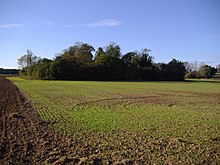Gresham Castle
Gresham Castle is a ruined castle south of the village of Gresham in the north of the English county of Norfolk . The medieval castle was actually a fortified mansion .
The owner, Sir Edmund Bacon , received a royal permit in 1318 to fortify his mansion (English: "License to Crenellate"). Gresham Castle was one of a group of later castles that were fortified or built along the east coast of England, which included Baconsthorpe Castle , Caister Castle , Claxton Castle and Mettingham Castle in Suffolk .
description
The castle ruins are located in a green field near the village. Its floor plan is rectangular and has an arched protrusion on the northwest corner. A moat around the property is 4-5 meters wide in places and still contains water, which can make it difficult to access the castle ruins. The water of the trench once came from the Gur Beck stream , which is now diverted and runs about 50 meters away from the castle ruins. The middle platform of the castle is approximately 2378 m² and carries round towers with a diameter of 10.6 meters. The ruins are now densely overgrown by trees, bushes and blackberry bushes, which makes an overview of the castle very difficult. The tower, which formerly stood in the southeast corner, protruded over the platform. The stone cladding of the two corner towers on the west facade can still be seen today, with one being much larger than the other. A part of the curtain wall up to a height of about 1.8 meters is still preserved between them. The foundations on the site show that there must have been towers on the east side in the past. The tower in the northwest corner was the size of a donjon . Large wooden beams believed to be the remains of a drawbridge and the keel of a boat were discovered when the surrounding moat was being cleaned in 1846.
history
In 1427 the lawyer William Paston († 1444) bought the castle and manor of Gresham to add to his already large possessions in Norfolk. Paston bought the castle and manor from Thomas Chaucer from Ewelme and William Moleyne , who had previously owned the property in equal parts. The legality of the sale, however, was of a nobleman from Wiltshire , Robert Hungerford, Lord Moleynes, 2nd Baron Hungerford , doubted. Later, when William Paston died, he left a great and precious inheritance to his son John Paston . Lord Moleyne's long-standing claim to half of the estate was supported by John Paston's bitter rival, John Haydon of nearby Baconsthorpe Castle . On February 17, 1448, troops led by Lord Moleynes attacked the fortified mansion directly, penetrated and began to collect leases from the tenants of the manor. After this incident, John Paston petitioned the king, and after his intervention, Paston claimed the property again on October 6th. On January 28th, Moleyne occupied the castle again with a force of 1,000 men, some from local forces and some from Wiltshire followers, this time driving Paston's wife Margaret by force, as well as 12 of her servants. A lieutenant from Moleyne's force named Partridge was left behind to barricade the castle against any attempt by Paston to reclaim his property. In the Paston Letters , Margaret explained to her husband:
"(...) Partridge and his cronies are so worried you might attack them again, and they have been issuing ordinances in the house, as I was told. They made bars to cross the gates and they put wickets in every quarter of the house so that they could shoot out from there, both with bows and arrows and with handguns. "
A year later, John Paston claimed the castle and the manor again, this time without resistance. He found the castle in very poor condition; one could no longer live there. In 1466 John Paston died, leaving his estates including Gresham Castle to his eldest son, also called John . In 1471 Sir John Gresham commissioned the reconstruction of Gresham Castle and sent his brother, who was also strangely called John , to survey the site and draw up plans for the reconstruction. However, this reconstruction never took place and the property was given up.
Individual evidence
- ↑ OS Explorer Map 252 - Norfolk Coast East . ISBN 978-0-319-23815-8 .
- ↑ a b c d e Anthony Emery: Great Medieval Houses of England and Wales, 1300-1500 . Cambridge University Press, Cambridge. ISBN 978-0-521-58132-5 . P. 110.
- ^ A b c d Norman Davis: Paston Letters and Papers of the Fifteenth Century . Oxford University Press, Oxford. ISBN 0-19-722421-0 .
- ^ Norman Davis (editor): The Paston Letters . Oxford University Press, Oxford: Letter from Margaret Paston to John Paston I dated September 28, 1443. ISBN 0-19-281615-2 .
Web links
Coordinates: 52 ° 53 '47 " N , 1 ° 13' 10.9" E

